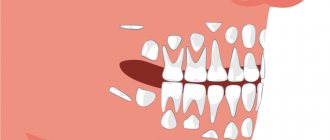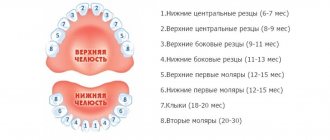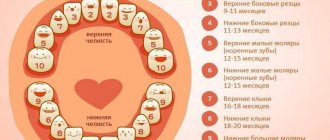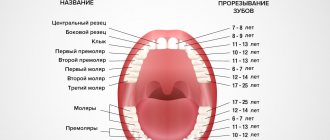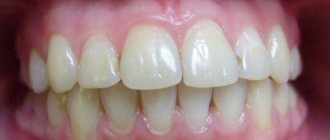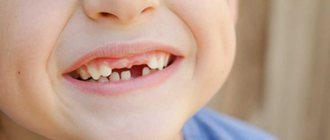The order of eruption of baby teeth.
The first teeth that a child begins to erupt at the age of 5 - 8 months on the lower jaw are the deciduous incisors. Next, the central primary incisors on the upper jaw begin to appear. At the age of 9 - 13 months, the lateral incisors on the upper and lower jaws erupt. At the age of 13 - 19 months, the first chewing teeth (first primary molars) are cut on the upper and lower jaws. A gap is formed between the lateral incisors and molars, during which the primary canine begins to erupt at 16 months. The last to begin to emerge is the second chewing tooth (second primary molar), first on the lower jaw, then on the upper jaw. By age 3, a full set of baby teeth should have formed.
Timing of adult teeth eruption
The rudiments of the first teeth (on average, about 20 units) in infants are formed during the first two years of life. When the time comes to replace them with permanent teeth, the milk teeth become loose and fall out. There are no specific dates for the eruption of molars; many factors can affect the speed: environmental conditions, climate, water quality and diet. Genetic characteristics also play a certain role, some of which make themselves felt even during the formation of the fetus. The influence can be both positive and negative. If parents have healthy teeth from birth, then you don’t have to worry about the child’s teeth. If the first incisors, canines and premolars grow in 3 years, then the permanent ones take a long time to erupt. The first symptoms of dentition change can be seen at the age of 5, and it continues until the age of 21, when the third molars appear.
Video: Timing of eruption of permanent teeth
Timing of eruption
Features of the period and symptoms of the eruption of the first teeth.
DATES OF TEETHING ARE INDIVIDUAL FOR EACH BABY AND DEPEND ON A NUMBER OF FACTORS: NUTRITION, HEREDITY, ETC. THIS IS WHY YOU SHOULD NOT WORRY MUCH IF THE LONG AWAITED APPEARANCE OF YOUR FIRST TEETH IS DELAYED.
PHOTO: Gums of a child at 6 months. Before the first baby teeth erupt, the gums in the area of the future teeth turn slightly white due to tooth pressure.
It's hard to miss when children's first teeth appear. As the tooth erupts, it “tightens” the mucous membrane (the tooth can be felt with your finger under the mucous membrane) and, having “broken through” it, ends up in the oral cavity. In some children, a bluish “bump” or “ball” with transparent contents forms on the mucous membrane above the erupting tooth. This is a small eruption cyst that usually breaks out on its own WITHOUT outside help (despite the menacing name), although sometimes the intervention of a pediatric dentist is required.
The first teeth that appear may be located asymmetrically and “not evenly” - this is the norm. Such dental disorder has the right to exist until the eruption of 16 teeth: baby teeth are independently ordered as they erupt, aligning each other. This is facilitated by the intake of solid food, pressure of the tongue and lip muscles.
In a normal primary occlusion, gaps form between the primary incisors and canines (on average 1 mm), which is normal and a sign that the permanent wider incisors will have enough space in the dentition during the period of physiological change of teeth. The absence of these spaces indicates a lack of space for permanent teeth.
In most cases, teething does not cause the child any discomfort, although sometimes the process of teething can be accompanied by “itching” of the gums and lead to sleep disturbances in the child, causing a lot of trouble for the child and his parents.
Molars in children
Of course, molars in children deserve a separate discussion. Firstly, because parents often confuse which teeth are milk and which are permanent, and secondly, because their eruption causes extremely unpleasant and even painful sensations and is often accompanied by an increase in temperature.
When do molars grow?
Many parents believe that molars are permanent teeth, that is, those that replace milk teeth. But actually it is not. So what kind of teeth does the child have? In fact, molars are divided into permanent and primary teeth. In this case, the order of eruption of molars in children is as follows. At six months, babies begin to notice their first molars. There are four of them, and they are located on the lower and upper parts of the jaw apparatus. At one and a half years, central molars appear, at two and a half, lateral molars. From 5 to 10 years, baby teeth are replaced by permanent teeth. Until about 25 years of age, the most complex tooth, the “wisdom” tooth, emerges.
What symptoms accompany tooth growth?
Not all parents know how their children’s molars grow, which is why they begin to worry a lot when they notice some unpleasant symptoms. Let's figure out what phenomena accompany tooth growth.
Fever. During the period of teeth growth, children can maintain a temperature of 37–37.5 °C. In some cases it rises to 38 °C. Why is this happening? The fact is that when the gums become swollen, the blood flow increases, and to compensate for the swelling, the body produces biologically active substances, which affects the state of the immune system. As a result, the temperature rises.
General malaise. Very often, when teething, children seem lethargic and tired. This is due to the fact that it is a lot of stress for the body. As a result, the child may have trouble sleeping; babies often become irritable, spit out the pacifier, start sucking their thumbs, and are constantly capricious.
Increased salivation. This is especially observed in young children (aged 5–7 months). At this time, they do not yet independently regulate the amount of saliva in their mouth. A large amount of saliva indicates irritation of the sensitive nerves of the gums, which is completely normal when teeth appear. Over time, with the development of the reflex, the amount of saliva decreases.
Digestive disorder. Teething is often accompanied by vomiting, diarrhea and regurgitation. The reason for this is an increase in the amount of liquid the baby drinks during the day.
How can I help you
In order to speed up the teething process, small children can be given special toys. They are usually made in the form of rings. Instead of these items, you can use a regular crust of bread or peeled fresh carrots. Also during this period, it is recommended that the child be given cool drinks, preferably just water. You can distract babies and older children with the help of games, conversations, and fun music. Do not forget that during this period the child needs double affection and special care from the parents. For severe pain, doctors prescribe age-appropriate analgesics. You can apply a clean, soft cloth soaked in cold water to your gums. This is especially useful before bedtime, as this approach will help relieve pain and allow the child to fall asleep.
Typical problems.
PHOTO: a child’s teeth at 3 years old. Gaps between baby front teeth at age 3 are normal. On the front upper teeth there is caries in the cervical area of the teeth.
There may be a slight rise in body temperature and anxiety in children when their first teeth are cut. This is due to minor inflammation and itching of the gums in the area where teeth are about to erupt. To relieve discomfort, it is recommended to treat the oral cavity with special napkins for oral hygiene, containing special antiseptic and tanning substances.
The most common problem faced by parents aged 12 - 18 months is “bottle” caries, the main cause of which is poor oral hygiene in the child and night feedings. As a result of poor hygiene, a large amount of soft plaque forms on the teeth. Plaque contains a large number of bacteria that produce acid, which “corrodes” the enamel, leading to the formation of caries.
Night feedings at the age of 12 - 18 months create the most favorable conditions for the development of caries, because... At night, saliva production is reduced - the acid of bacteria living in dental plaque is not neutralized.
BREAST-fed children are LESS likely to develop dental caries than bottle-fed children. Breast milk helps saturate the surface of teeth with calcium and phosphate ions. Breast milk contains a large number of immunological protective factors. At the same time, it has been noted that long-term night feeding (both breast and bottle feeding) leads to the development of dental caries, especially in the area of the upper front milk teeth.
PHOTO: A one and a half year old child’s teeth. The front incisors and first molars have erupted. The fang (3rd tooth) is emerging. Often at this age the first injuries occur: the child fell and hit his front upper tooth - the tooth broke.
Against the background of poor hygiene and a weakened immune system, inflammatory diseases of the mucous membrane and stomatitis may develop. Stomatitis in young children is severe, accompanied by general malaise, loss of appetite and increased body temperature.
IT IS VERY IMPORTANT TO START TEACHING YOUR CHILD TO THE NECESSITY OF INDIVIDUAL ORAL HYGIENE FROM THE MOMENT OF THE APPEARANCE OF THE FIRST TEETH. GOOD ORAL HYGIENE IN A CHILD IS THE KEY TO HEALTHY TEETH FROM EARLY CHILDHOOD.
Caring for children's teeth
The pattern of teething in children determines the approximate time of their appearance, but it is necessary to start observing oral hygiene as early as possible, without waiting for the teeth to erupt.
Breasts cannot take care of themselves, so they need help cleaning their gums. This is done either with the help of a fingertip, or, if there is none, with the help of an ordinary bandage dipped in warm boiled water and wound around the finger.
If teeth begin to erupt, you cannot do without the use of special products (baby pastes, brushes, etc.).
Treatment.
Providing QUALITY dental care to children from the moment the first tooth appears and up to 3 years of age is LIMITED to physiological reasons: mild excitability, restlessness, fear of unknown manipulations in the oral cavity. An attempt to cure teeth by talking to a child or holding him by force in his arms ends with POOR-QUALITY treatment, as a result of which various local complications can develop.
REMEMBER: FORCED TREATMENT WITH CHILDREN RESTRAINT CAUSES IRREPAIRABLE PSYCHOLOGICAL TRAUMA TO THE CHILD!
Like
Timing of appearance of temporary teeth
The order in which teeth appear is determined by the importance of each of them in the process of food processing. Therefore, the central and lateral incisors are shown first, then the canines and first molars, and the second molars last. The principle of “pairing” operates in this process. This means that if one central incisor has erupted, a second one will soon appear, and so on. In this case, the teeth of the lower jaw appear first, then the upper ones. The exception is the lateral incisors; they cut faster in the upper jaw. The process of formation of a temporary bite is completed in a period of 2 to 3 years.
Important: the diagram shows average time intervals. But each person is individual, so the schedule may be shifted in one direction or another. It depends on many factors. Parents should not worry if their baby’s teeth begin to appear a little earlier or later than indicated in the diagram. You should contact a specialist if teething has delayed for 2 - 3 months from the maximum period.
Symptoms and first signs of wisdom tooth growth
Seal
The structure of third molars or “eights” is no different from other teeth. Their peculiarity is different. Wisdom teeth erupt much later than others - on average, this occurs at 18-26 years of age. Since the dental system has already been formed by this time, there is not much free space left. The third molar is forced to “conquer” space from its neighbors.
The result is unpleasant sensations and even severe pain. In addition, teething can cause inflammation, against which complications such as abscess, phlegmon, etc. develop. To avoid undesirable consequences, you should know the symptoms and consult a dentist at the first signs of wisdom tooth growth.
Khashchenko Stanislav Sergeevich is a dental surgeon at the Dentoclass clinic.
How does eruption occur and what signs indicate its beginning?
An interesting feature of the “eight” is that it erupts immediately - without preliminary preparation of the gums with a baby tooth. For this reason, the process is much like the growth of teeth in young children. The formed tooth is, as it were, pushed outward, overcoming the resistance of bone and soft tissues. At the same time, the gums swell and become more sensitive. Then a small wound is formed at the site of tooth growth, after which the upper part of the crown appears.
The most common signs of third molar eruption are:
- mild, but constant aching pain caused by the fact that the “eight” makes its way through bone and soft tissue;
- redness and swelling of the gums are normal to a small extent, but severe swelling indicates the development of inflammation;
- discomfort or severe pain when swallowing, as well as when trying to open your mouth wide;
- enlarged lymph nodes under the jaw due to an increasing inflammatory process;
- the formation of a hood of soft tissue covering the partially erupted figure eight.
Note! Due to the location of the “eights”, access to them is difficult. This negatively affects the quality of hygiene. As a result, food particles accumulate under the hood, which serve as a breeding ground for the development of pathogens. This is how pericoronitis begins - the most common complication that occurs when wisdom teeth erupt. If this process is ignored, the inflammation progresses and in the future, hospital treatment may be required to stop it.
Pericoronitis is the most common complication of wisdom tooth eruption.
What can and cannot be done during the eruption of wisdom teeth?
The best thing you can do when you have suspicions about the growth of the “eight” is to consult a dentist. The doctor will perform an examination, recommend anti-inflammatory and painkillers, prescribe an x-ray or an orthopantomogram to assess the position of the tooth in the image and make sure that the latter is growing correctly and is not pressing on the root of the “seven”. Also, if indicated, the dental surgeon can remove the hood. The procedure is performed using local anesthesia and significantly alleviates the patient's condition.
A visit to the clinic is the best solution. But sometimes it happens that the patient for some reason is forced to postpone visiting the doctor. In this case, it is very important to know what you can and cannot do. So:
| Can: | It is forbidden: |
|
|
In conclusion, it should be noted that in case of severe pain, increased body temperature or general deterioration in health, you should immediately visit the dentist. These conditions indicate the development of serious inflammation that can cause significant harm to the patient's health.
Still have questions? Sign up for a consultation at our clinic or call:
8 8
Liked? Tell your friends!


